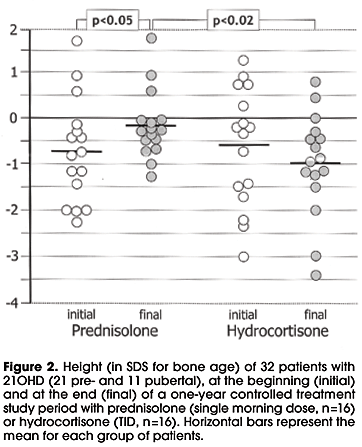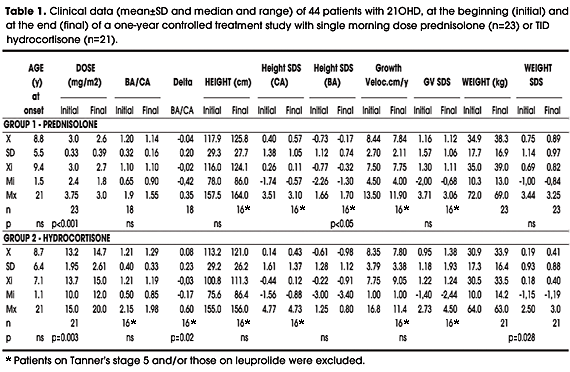Replacement schedules with hydrocortisone (HC) to treat 21OHD are generally unsatisfactory and partially successful regarding growth. Noncompliance is common since its short half-life requires TID administration. Even multiple daily HC doses do not reproduce cortisol chronobiology and may disturb hypothalamic-mediated rhythms. Because synthetic glucocorticoids could improve clinical control, we evaluated the possible benefits of a one-year treatment period with a single morning oral dose of prednisolone (PD) phosphate in 44 patients with 21OHD randomized to two sex and age-matched groups: one (n=23) receiving PD (2.4-3.5mg/m² BSA) and the other (n=21) TID HC (10-15mg/m² BSA). After one year, bone maturation ratio was kept stable in the PD group (from 1.20 to 1.14), whereas a slight increase was seen in the HC group (from 1.21 to 1.29). Growth velocity (SDS) was preserved in the PD group (from 1.2 to 1.2 in all; 0.79 to1.13 in pre-pubertals), whereas a slight increase occurred in the pre-pubertal HC-treated patients (from 1.1 to 1.9); height SDS for BA increased significantly in the PD group. Thus, patients with 21OHD treated for one year with a single morning dose of PD appear to achieve a better clinical and hormonal control than those on TID HC, permitting a reduction of the replacement dose. The current PD schedule used by our group (1.5-3mg/m² BSA/day) suggests a higher HC:PD bioequivalence ratio of 6-8:1.
21-Hydroxylase deficiency; Prednisolone; Hydrocortisone; Growth; Androgens






